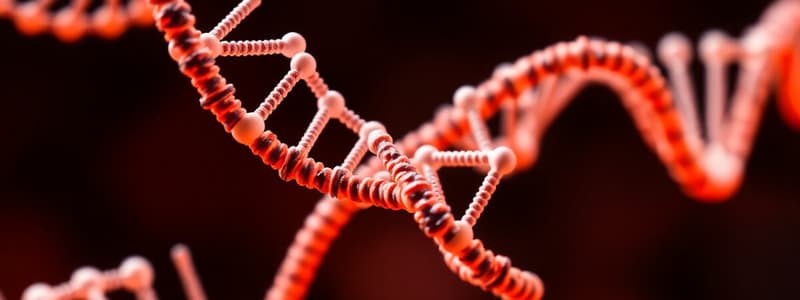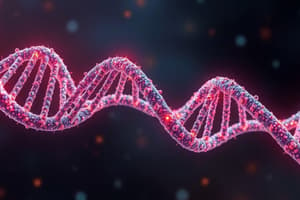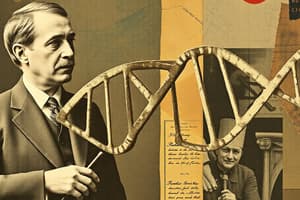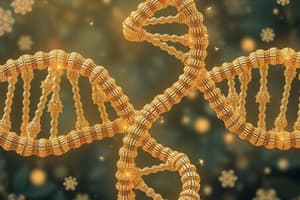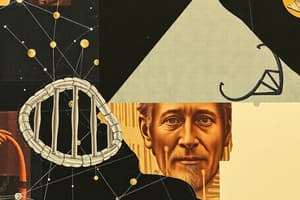Podcast
Questions and Answers
Which scientist's experimental work was crucial in providing evidence for the double helix structure of DNA, although their contribution was not fully recognized initially?
Which scientist's experimental work was crucial in providing evidence for the double helix structure of DNA, although their contribution was not fully recognized initially?
- Francis Crick
- Maurice Wilkins
- James Watson
- Rosalind Franklin (correct)
What structural feature of DNA ensures that during replication, each new molecule contains one original and one newly synthesized strand?
What structural feature of DNA ensures that during replication, each new molecule contains one original and one newly synthesized strand?
- The equal ratio of bases
- The specific pairing of bases (correct)
- The double helix shape
- The phosphoric acid backbone
If a DNA molecule contains 20% adenine, what percentage of guanine would it possess?
If a DNA molecule contains 20% adenine, what percentage of guanine would it possess?
- 30% (correct)
- 40%
- 60%
- 20%
Apart from contributing to the understanding of DNA replication, what broader impact has the discovery of DNA's structure had on scientific fields like medicine?
Apart from contributing to the understanding of DNA replication, what broader impact has the discovery of DNA's structure had on scientific fields like medicine?
What specific feature of DNA allows it to encode the vast amount of information required to direct cellular activities and development?
What specific feature of DNA allows it to encode the vast amount of information required to direct cellular activities and development?
What was the significance of the year 1953 in the context of DNA?
What was the significance of the year 1953 in the context of DNA?
How do the 'rungs' of the DNA 'ladder' contribute to its functionality?
How do the 'rungs' of the DNA 'ladder' contribute to its functionality?
What key observation about DNA's chemical composition informed Watson and Crick's model building?
What key observation about DNA's chemical composition informed Watson and Crick's model building?
Why was Franklin's Photo 51 so important to understanding the structure of DNA?
Why was Franklin's Photo 51 so important to understanding the structure of DNA?
What was the main reason for awarding the 1962 Nobel Prize in Physiology or Medicine regarding DNA?
What was the main reason for awarding the 1962 Nobel Prize in Physiology or Medicine regarding DNA?
Flashcards
Double Helix
Double Helix
The DNA structure shaped like a twisted ladder.
Francis Crick and James Watson
Francis Crick and James Watson
Scientists who proposed the double helix model of DNA.
Rosalind Franklin
Rosalind Franklin
Scientist who provided key X-ray images of DNA.
Maurice Wilkins
Maurice Wilkins
Signup and view all the flashcards
1953
1953
Signup and view all the flashcards
Nobel Prize
Nobel Prize
Signup and view all the flashcards
Paired Bases
Paired Bases
Signup and view all the flashcards
Genetic Code
Genetic Code
Signup and view all the flashcards
Equal Ratios
Equal Ratios
Signup and view all the flashcards
Replication
Replication
Signup and view all the flashcards
Study Notes
DNA Structure and Discovery
- DNA structure resembles a twisted ladder (double helix)
- Phosphate and sugar form the "uprights" of the ladder
- Paired nucleotides (bases) form the "rungs"
- Adenine pairs with Thymine (A-T)
- Guanine pairs with Cytosine (G-C)
- These pairings always occur in equal ratios
- The order of DNA bases forms the genetic code
- X-ray crystallography image (Photo 51) by Rosalind Franklin helped Watson and Crick determine DNA structure
- Watson and Crick developed a model of the DNA double helix
- Published their findings in a landmark paper in 1953
Scientific Breakthrough
- Crick and Watson's work revolutionized our understanding of genetics
- Marked a turning point in 20th-century science
- Paved the way for advances in molecular biology
- Watson, Crick, and Wilkins shared the 1962 Nobel Prize in Physiology or Medicine
- Franklin's contribution to the work was not widely recognized before her passing in 1958
Studying That Suits You
Use AI to generate personalized quizzes and flashcards to suit your learning preferences.
